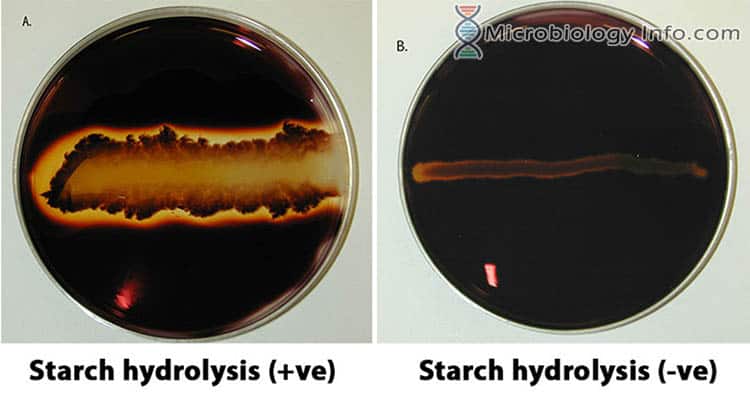- Starch is a complex polysaccharide found abundantly in plants and usually deposited in the form of large granules in the cytoplasm of the cell.
- Starch consists of 2 components—amylose and amylopectin, which are present in various amounts.
- The amylose consists of D-glucose units linked in a linear fashion by α-1,4 linkages. It has 2 non-reducing ends and a reducing end.
- Amylopectin is a branched polysaccharide. In these molecules, shorter chains of glucose units linked by α-1,4 are also joined to each other by α-1,6 linkages.
- The major component of starch can be hydrolyzed by a-amylase, which is present in some bacteria while well known in case of fungi.
- The ability to degrade starch is used as a criterion for the determination of amylase production by a microbe.
Objective
- To determine the ability of an organism to hydrolyze starch
- To differentiate organism based on their α- amylase enzyme activity
Principle
Many bacteria produce extracellular enzymes used to catalyze chemical reactions outside of the cell. In this manner, nutrient sources, such as starch, that are too large to be absorbed through the cell membrane can be broken down into smaller molecules and transported into the cell via diffusion.
In the starch hydrolysis test, the test bacteria are grown on agar plates containing starch. If the bacteria have the ability to hydrolyze starch, it does so in the medium, particularly in the areas surrounding their growth while the rest of the area of the plate still contain non-hydrolysed starch. Since no color change occurs in the medium when organisms hydrolyze starch, iodine solution is added as an indicator to the plate after incubation. While the non-hydrolysed starch forms dark blue color with iodine, its hydrolyzed end products do not acquire such dark blue color with iodine.
Consequently, transparent clear zones are formed around the colonies that hydrolyze starch while the rest of the plate show a dark blue coloration as iodine forms the colored complex with starch.
Media:
Starch agar is a simple nutritive medium with starch added. Beef extract and pancreatic digest of gelatin provide nitrogen, vitamins, carbon and amino acids. Agar is the solidifying agent and starch is the carbohydrate.
Composition:
Peptic digest of animal tissue 5.000, Sodium chloride 5.000, Yeast extract 1.500, Beef extract 1.500 Starch, soluble 2.000 Agar 15.000 Final pH ( at 25°C) 7.4±0.2
Method
- Using a sterile technique, make a single streak inoculation of organism to be tested into the centre of labeled plate.
- Incubate the bacterial inoculated plates for 48 hours at 37°C.
- Following incubation, flood the surface of the plates with iodine solution with a dropper for 30 seconds.
- Pour off the excess iodine.
- Examine for the clear zone around the line of bacterial growth.
Expected Results
- Positive test:A clear zone around the line of growth after addition of iodine solution indicates that the organism has hydrolyzed starch.
- Negative test:A blue, purple, or black coloration of the medium (depending on the concentration of iodine).

Uses
- It aids in the differentiation of species of genera Corynebacterium, Clostridium, Bacillus, Bacteroides, Fusobacterium, and members ofEnterococcus spp.
Limitations
- It is recommended that biochemical, immunological, molecular, or mass spectrometry testing be performed on colonies from pure culture for complete identification.
- Colonies cannot be subcultured from the medium after the addition of Gram’s iodine due to the oxidative nature of the reagent and the resulting cell death.
References
- Tille P.M. 2014. Bailey and Scott’s diagnostic microbiology. Thirteen edition. Mosby, Inc., an affiliate of Elsevier Inc. 3251 Riverport Lane. St. Louis. Missouri 63043
- https://www.austincc.edu/microbugz/starch_hydrolysis.php
- https://www.himedialabs.com/TD/M107.pdf
- https://www.uwyo.edu/molb2210_lab/info/biochemical_tests.htm
- https://catalog.hardydiagnostics.com/cp_prod/Content/hugo/StarchAgar.html
- https://www.yourarticlelibrary.com/experiments/starch-hydrolysis-test-on-bacteria-to-find-out-their-ability-to-hydrolyse-starch/26587
- https://www.sas.upenn.edu/LabManuals/biol275/Table_of_Contents_files/21-DiagnosticTests.pdf
- http://www.asmscience.org/content/education/imagegallery/image.3172
- https://biocyclopedia.com/index/biotechnology_methods/microbiology/starch_hydrolysis_test_ii_method.php
Similar Posts:
- Deoxyribonuclease (DNase) Test – Principle, Procedure, Uses and Interpretation
- Benedict’s Test- Principle, Composition, Preparation, Procedure and Result Interpretation
- Simmons Citrate Agar- Composition, Principle, Uses, Preparation and Result Interpretation
- Oxidase Test- Principle, Uses, Procedure, Types, Result Interpretation, Examples and Limitations
